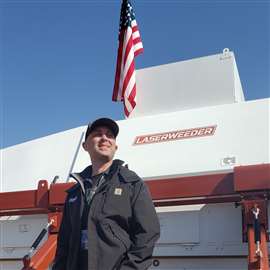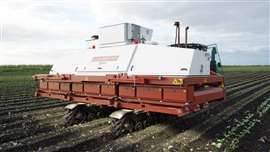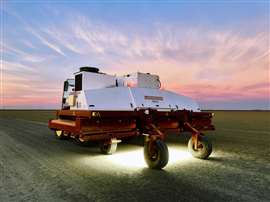Read this article in Français Deutsch Italiano Português Español
Carbon Robotic’s laser-wielding robot weeders
06 May 2024
Carbon Robotics updates LaserWeeder implement for growers worldwide
 Carbon Robotics first launched the pull-type LaserWeeder in 2022. The company launched a track version of its weed management tool during World Ag Expo in February 2024. (Photo: Carbon Robotics)
Carbon Robotics first launched the pull-type LaserWeeder in 2022. The company launched a track version of its weed management tool during World Ag Expo in February 2024. (Photo: Carbon Robotics)
Carbon Robotics has employed computer vision, artificial intelligence (AI) and lasers to help keep weeds at bay, and its success in the field has convinced specialty crop growers around the world to employ its weed control implement. Last year, the company saw LaserWeeder sales triple compared to 2022.
“Our customers laser weeded for more than 50,000 total hours last year across more than 100 different crops, capturing major savings in weed control costs and reporting substantial increases in crop yield and quality,” said Paul Mikesell, CEO and founder of Carbon Robotics, based in Seattle, Wash.
When Mikesell started the company in 2018, his first task was to perfect an AI system that could identify crops and weeds. Several generations later, the system employed by the tractor-pulled implement can see and learn as it travels through the field, ensuring weeds are removed with laser-like precision -- literally.
“That’s part of our specialty today,” said Mikesell. “Our AI computer vision system is identifying weeds on location based on what the camera sees. Then, using optics and control systems, we’re able to target each laser at the weeds. From the bottom of the machine, a laser beam hits the weed that we’ve identified. We use thermal energy from the laser to burn out the meristem, which is the growth center of the plant. It does this at speed. We’ve gotten rid of chemicals all together.”
No weeds, no chemicals
Each LaserWeeder carries an on-board generator driven by the tractor’s power take-off (PTO) to power 30 individual 150 W lasers, 42 high-resolution cameras and the control system itself. The lasers are reportedly ready to fire every 50 milliseconds, eradicating up to 300,000 weeds across 1 to 3 acres every hour. The company said the LaserWeeder implement can cut weed control costs by 80%.
“There’s a lot of power up in there,” said Mikesell, “and we’re killing these weeds.”
Agricultural equipment engineers have long sought technology that will help application equipment and their operators reduce chemical inputs.
“There are a lot of positive side effects to not spraying,” said Mikesell. “There’s the downstream effects of runoff, of course. But perhaps the biggest thing that we’ve discovered is that growers are getting big yield increases because herbicides tend to knock crops back in their growing cycle. When you don’t have to spray, you get much better yield. Customers are getting better quality crops, with a higher percentage of them coming to harvest. That’s led to increased volume coming out of the fields and, as a result, more income.”
Hitch-mounted robot
When Carbon Robotics first showed growers what it had been working on, it did so with an autonomous, self-propelled robot. The box-like machine is powered by a Cummins QSF2.8 diesel engine rated 74 hp that drove hydraulic motors at each of the four wheels. While the prototype machine is still used for field demonstrations, the company ultimately went to market in early 2022 with a 20 ft. wide implement that is pulled behind a standard row-crop tractor equipped with a Category 3 three-point hitch.
 Paul Mikesell, CEO and founder, Carbon Robotics. (Photo: Carbon Robotics)
Paul Mikesell, CEO and founder, Carbon Robotics. (Photo: Carbon Robotics)
“There are quite a few regulatory challenges to overcome to make the autonomous robot viable, and a lot of exception cases,” said Mikesell. “You must solve so many exceptions to make it usable – such as irrigation pipes, ditches and rocks – that we did not want that process to get in the way of customers benefiting from using LaserWeeders. Every farm is different, and every farmer does things in a special way. There is a lot involved with getting a machine out of a shed and transporting it to the field, and that involves decisions that people handle every day. We felt it was much better to let them continue to manage those processes with somebody in the cab of the tractor.”
Rather than navigate between Point A and B, today’s LaserWeeder employs its cameras and deep learning to completely automate the monotonous job of hand-weeding acres of soon-to-be salad ingredients.
“If a grower has dozens of people pulling weeds, you can replace them with one person driving a tractor. And that’s still a very great cost benefit,” said Mikesell. “One thing we always point out is that we’re not really taking away jobs. Farmers are struggling to find people to do this work. We’re using technology to allow farmers to grow at scale without struggling to keep up with the labor demand.”
Plus, most of the farmers who want to know what a LaserWeeder will mean to their individual operations already have a fleet of tractors to pull the machine.
 The Track LaserWeeder permits its use in all types of fields, including muck soil. (Photo: Carbon Robotics)
The Track LaserWeeder permits its use in all types of fields, including muck soil. (Photo: Carbon Robotics)
Latest updates revealed
During February’s World Ag Expo in Tulare, Calif., Carbon Robotics showed several updates on the LaserWeeder, including a tracked model and software enhancements.
The new Track LaserWeeder uses two systems built in collaboration with Canada-based track specialist Soucy International and GK Machine, an agricultural equipment OEM and contract manufacturer in Oregon. The application of tracks rather than wheels is expected to extend the implement’s usability across a wide range of soil types, including muck soil, and minimize compaction from the 12,600 lb. machine. The company said it already has orders for the tracked weeder and the first units have been delivered to growers.
“Custom tracks extend the versatility and flexibility of the LaserWeeder and open up laser weeding to more regions and farms with varying soil types,” said John Mey, vice president of product, Carbon Robotics. “By improving ground pressure to 6.5 psi and supporting row spacing of 64 to 90 in., growers in muck regions now can use LaserWeeder to do the work of a 75-person hand weeding crew, have an alternative to herbicides, and gain the production benefits resulting from no soil disruption.”
At the show, the company also introduced visualized spatial data to its customers, which it said will permit growers to access field, crop and weed metrics within its Carbon Ops Center, including stand count, density, type, average plant size and distribution.
“We’ve been working internally on the Carbon Ops Center for quite some time,” said Mikesell, “and this update allows growers to do crop and weed analytics, allowing them to see what’s happening in their fields over time. Growers can use the system to figure out where weeds are coming from: they can see it on the map and watch weeds show up and spread into the field. With that view, they can see they’re getting purslane from an irrigation ditch, for example. We break it down by weed type so you can actually tell the species of the plant, which is very, very helpful.”
The technology is good for more than recording the weed population, said Mikesell. “Growers can also use it to see how much of the crop is coming through and how big and healthy they are. We’re going to keep adding to that functionality, too. We will have several other software updates this year to let farmers get a lot more information about what’s happening in the field. We can do that because these machines are in fields learning right now.”
The company also announced that the iPad-based application that runs the implement is now translated into eight languages, including Spanish and English. “Because we’re in Europe a lot now, we have French, German, Danish, Polish, Romanian and Dutch translations,” said Mikesell. “And although Australia doesn’t need a language translation, we’ve also been selling a lot of units there.”
 Lighting the crop bed ensures the cameras and lasers work together anytime of the day, with each laser hitting weeds with millimeter accuracy. (Photo: Carbon Robotics)
Lighting the crop bed ensures the cameras and lasers work together anytime of the day, with each laser hitting weeds with millimeter accuracy. (Photo: Carbon Robotics)
Carrots and bok choy
The LaserWeeder is currently programmed to work in 100 different crops, of which the most common these days are onions, carrots and lettuce – all crops that go from field to grocery store in the span of a few days.
“We do everything from radishes to bok choy to broccoli and cauliflower,” said Mikesell, “and we can pick up a new crop type in 24 hours. When we get to a new field, we take pictures, train the AI, and we’re ready to go the next day. The machine just keeps learning from that and will get better and better.”
As a technology company, Carbon Robotics works with several contract manufacturers to produce the robotic weed eradicator. Final assembly happens in suburban Detroit.
To support continued growth and new product development, Carbon Robotics said it raised $43 million in new capital in 2023, bringing its total funding to $80 million since it was founded.
This article originally appeared in the April 2024 of Power Progress magazine.
POWER SOURCING GUIDE
The trusted reference and buyer’s guide for 83 years
The original “desktop search engine,” guiding nearly 10,000 users in more than 90 countries it is the primary reference for specifications and details on all the components that go into engine systems.
Visit Now
STAY CONNECTED




Receive the information you need when you need it through our world-leading magazines, newsletters and daily briefings.
CONNECT WITH THE TEAM













